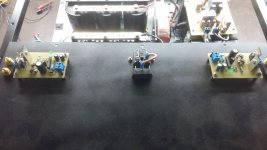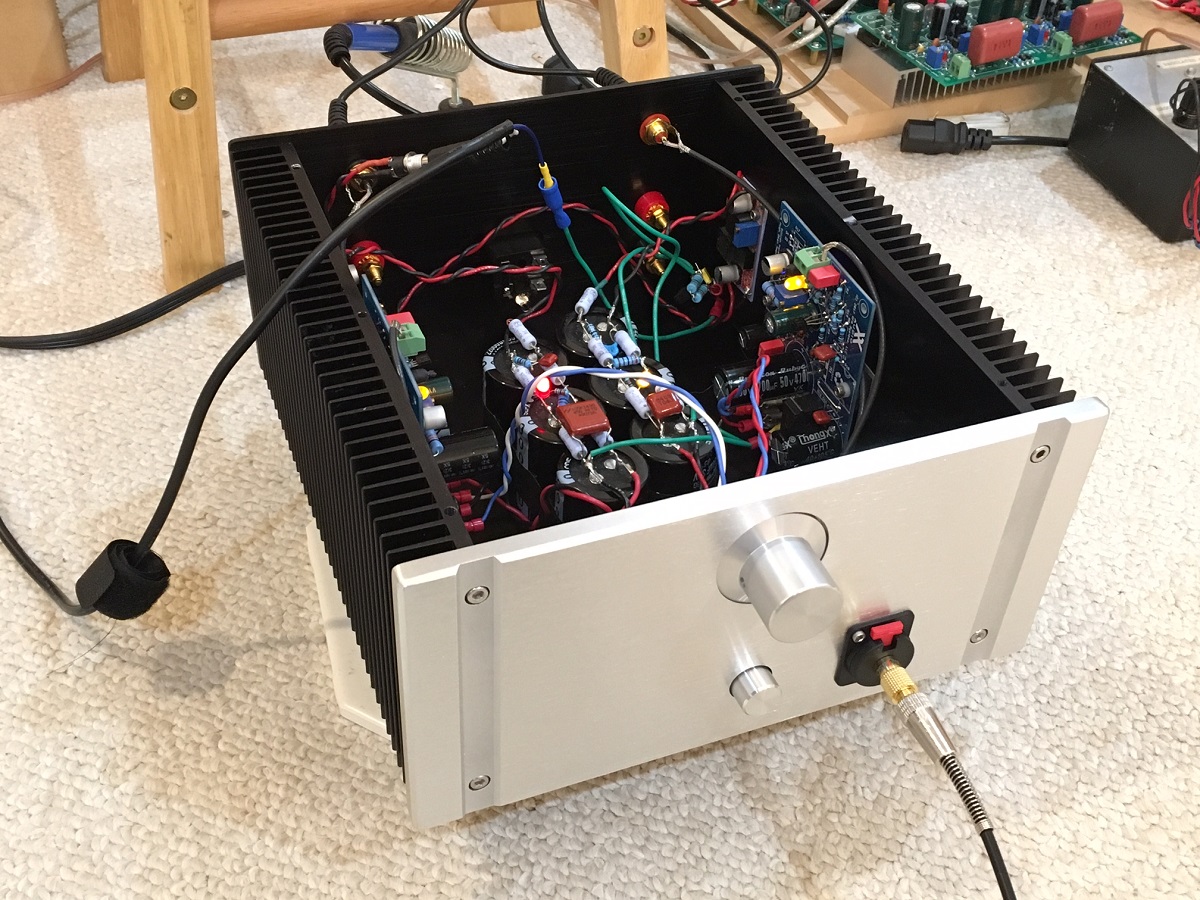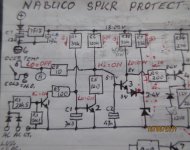Dacz, the turn off circuit is just to switch opto off faster, If you remove the power from the 3906 then they switch off immediately and are extremely cheap. 0.3 ms seems ok to me.
Why put them on dissipators, are they heating ?
You know what's a great speaker protection kit that's foolproof? Two back to back 6800uF caps bypassed with a 10uF film cap.
Yes, but once You can develop the amp for this protection, You can use single + rail, and save one 6800uF capacitor...
Sajti
Yes, even single 4700uF is fine with single rail SE Class A
And so, you don't need any DC sniffing, your speaker protection is only a delay board with an AC sniffing on the transformer input ?
Last edited:
is this what you are looking for?I've designed a circuit by myself because it seems extremely difficult to detect defects in the AC.
When the stormy weather is here, there are some erratic small and fast series of power cuts, and all boards that i've buyed (including mainstream market amplifiers) or designed are in trouble.
How can you differtiate small cutted and distorded sinewaves of the regular distorded and dephased sinewaves please ?
The two diodes lower left each allow halfwave pulses to pass to the resistor attenuator R1&R2
Q1 pulses and discharges C1 repeatedly as long as AC is present.
Loss of AC turns on Q2 and that discharges C2 turning off the relay.
Q1 & Q2 is the D.Self loss of AC detector.
On a bad day I can suffer half a dozen complete power loss that restarts about 30seconds to 2minutes later, or stays off.
And suffers brown outs where voltage drops to less than 50% of nominal voltage.
Attachments
Last edited:
And so, you don't need any DC sniffing, your speaker protection is only a delay board with an AC sniffing on the transformer input ?
Not quite sure what is meant by "sniffing"? DC protection or detection?
Anyhow, for my single rail (Vcc 28v to 34v dc) SE Class A amp, the output is completely AC coupled with a 4700uF electrolytic cap (+ve polarity facing into the output device where DC is about 1/2Vcc or 14v to 17v) and also a 100uF to 220uF electrolytic in parallel plus a 2.2uF to 4.7uF MKT film cap in parallel.
There is no turn-on or turn-off transient thump. A graceful smooth decay on turn-off oer 10 seconds, and turn-on is maybe smooth rise in 1sec. I am using qnty 3 x 22,000uF caps on the PSU RCRCRC filter though.
Absolutely passive protection and passive turn-on thump protection - sort of OT for this thread - but nonetheless, shows what is possible when one lets go of the need to say "my amp is purely DC-coupled and there isn't a single cap in the signal path..." madness.
Last edited:
is this what you are looking for?
The two diodes lower left each allow halfwave pulses to pass to the resistor attenuator R1&R2
Q1 pulses and discharges C1 repeatedly as long as AC is present.
Loss of AC turns on Q2 and that discharges C2 turning off the relay.
Q1 & Q2 is the D.Self loss of AC detector.
On a bad day I can suffer half a dozen complete power loss that restarts about 30seconds to 2minutes later, or stays off.
And suffers brown outs where voltage drops to less than 50% of nominal voltage.
Thanks,
Have you tried this schematic with erratic on/off switch cycles (like a child playing very fast with the switch room light) ?
It seems to work only if there are complete sinusoids on the AC, but how many sinusoids did it need to trigg the relay ?
Last edited:
You know what's a great speaker protection kit that's foolproof? Two back to back 6800uF caps bypassed with a 10uF film cap.
These caps will add more distortion. If you are building low THD amp
better avoid it if possible.
Not quite sure what is meant by "sniffing"? DC protection or detection?
Anyhow, for my single rail (Vcc 28v to 34v dc) SE Class A amp, the output is completely AC coupled with a 4700uF electrolytic cap (+ve polarity facing into the output device where DC is about 1/2Vcc or 14v to 17v) and also a 100uF to 220uF electrolytic in parallel plus a 2.2uF to 4.7uF MKT film cap in parallel.
There is no turn-on or turn-off transient thump. A graceful smooth decay on turn-off oer 10 seconds, and turn-on is maybe smooth rise in 1sec. I am using qnty 3 x 22,000uF caps on the PSU RCRCRC filter though.
Absolutely passive protection and passive turn-on thump protection - sort of OT for this thread - but nonetheless, shows what is possible when one lets go of the need to say "my amp is purely DC-coupled and there isn't a single cap in the signal path..." madness.
Detection for protection
I'm not the only one that uses DC decoupling on the outputs... there are turn-on or turn-off transient thump with my flickering AC sometimes, so i must use very slow recovering speakers relays any very fast recovering PSU relays.
Your amplifier can resist to a child playing very fast with the on switch in order to make it sick ?
These caps will add more distortion. If you are building low THD amp
better avoid it if possible.
I don't know everything (tell me if i'm wrong) but the THD seems more than OK with this AC coupled design ?
Page 6 :
http://www.ti.com/lit/ds/slos611/slos611.pdf
Detection for protection
I'm not the only one that uses DC decoupling on the outputs... there are turn-on or turn-off transient thump with my flickering AC sometimes, so i must use very slow recovering speakers relays any very fast recovering PSU relays.
Your amplifier can resist to a child playing very fast with the on switch in order to make it sick ?
Yes, I tried switching on/off quickly and repeatedly. Still passively works and no turn on/off thump at all. Disconnecting the RCA jacks and hot plugging in is another matter though. Volume knob needs to be turned down to do that. But that is general rule for all amps.
I don't know everything (tell me if i'm wrong) but the THD seems more than OK with this AC coupled design ?
Page 6 :
http://www.ti.com/lit/ds/slos611/slos611.pdf
0.02% to 0.05% THD is typical of a good SE Class A designs and this amp is no different. Cap distortion is probably well below this level.
TPA3125D2 Class D is completely different topology but SE THD at 5w of 0.04% is very good, IMO. The profile is also important. Not just the value. Should be monotonically decreasing towards higher orders with little above 5th harmonic, preferably 3rd.
Last edited:
Yes, I tried switching on/off quickly and repeatedly. Still passively works and no turn on/off thump at all. Disconnecting the RCA jacks and hot plugging in is another matter though. Volume knob needs to be turned down to do that. But that is general rule for all amps.
My amplifiers don't use any volume control, everything is treated at full power.
0.02% to 0.05% THD is typical of a good SE Class A designs and this amp is no different. Cap distortion is probably well below this level.
TPA3125D2 Class D is completely different topology but SE THD at 5w of 0.04% is very good, IMO. The profile is also important. Not just the value. Should be monotonically decreasing towards higher orders with little above 5th harmonic, preferably 3rd.
I use it in a BTL configuration (fully balanced 20W at 8ohm) and the first board is ready for measurements but i don't have any spectrum analyzer.
There is 3.7mV of DC before output caps and no background noise at all (perhaps thanks to the high PSRR of the chip and high quality EI transformers) and no oscillation.
I must admit, that chip is great (through hole single sided PCB is not dead
 )
)
Last edited:
TI makes great Class D chips and I used TPA3116D2 and 3118D2 extensively for years. I was one of the first few people on DIYA to make my own TPA3118 amp from scratch before the cheap eBay variants flooded the market. However, once I built my first good discrete output stage Class AB amp and heard the difference, there was no going back to Class D. One thing I noticed is that Class D sounds fine until you hear the bass authority on a Class AB or Class A with a huge MOSFET output transistor that is 8x the size of the entire Class D chip! The flow of current is effortless. Plus, try connecting some 112dB/mW headphones to a Class D output. Is it silent to the point of you can't know if it's turned on even? I tried this and even with 96dB cans, there was a very audible hiss (remains of the switching noise leaking through). Sounds fine on a speaker and is tolerable - but not on headphones.
TI makes great Class D chips and I used TPA3116D2 and 3118D2 extensively for years. I was one of the first few people on DIYA to make my own TPA3118 amp from scratch before the cheap eBay variants flooded the market. However, once I built my first good discrete output stage Class AB amp and heard the difference, there was no going back to Class D. One thing I noticed is that Class D sounds fine until you hear the bass authority on a Class AB or Class A with a huge MOSFET output transistor that is 8x the size of the entire Class D chip! The flow of current is effortless. Plus, try connecting some 112dB/mW headphones to a Class D output. Is it silent to the point of you can't know if it's turned on even? I tried this and even with 96dB cans, there was a very audible hiss (remains of the switching noise leaking through). Sounds fine on a speaker and is tolerable - but not on headphones.
I still have vintage stock components and i will build one class AB amplifier for a direct comparison.
From Doug Self:
The distortion generated by an AC-coupled amplifier's output capacitor is more serious, as it is not confined to low frequencies. A 6800uF output capacitor driving 40 W into an 8-Ohm load gives mid-band third-harmonic distortion at .0025%, as shown in Fig 32. This is five times more than a Blameless amplifier generates mid-band. Also, the LF THD rise is much steeper than in the small-signal case.
=============
I guess in this case, for 5W output, maybe it doesn't matter much...
The distortion generated by an AC-coupled amplifier's output capacitor is more serious, as it is not confined to low frequencies. A 6800uF output capacitor driving 40 W into an 8-Ohm load gives mid-band third-harmonic distortion at .0025%, as shown in Fig 32. This is five times more than a Blameless amplifier generates mid-band. Also, the LF THD rise is much steeper than in the small-signal case.
=============
I guess in this case, for 5W output, maybe it doesn't matter much...
I don't know everything (tell me if i'm wrong) but the THD seems more than OK with this AC coupled design ?
Page 6 :
http://www.ti.com/lit/ds/slos611/slos611.pdf
From Doug Self:
The distortion generated by an AC-coupled amplifier's output capacitor is more serious, as it is not confined to low frequencies. A 6800uF output capacitor driving 40 W into an 8-Ohm load gives mid-band third-harmonic distortion at .0025%, as shown in Fig 32. This is five times more than a Blameless amplifier generates mid-band. Also, the LF THD rise is much steeper than in the small-signal case.
=============
I guess in this case, for 5W output, maybe it doesn't matter much...
SE=10W
BTL=20W
.0025% of THD is low (very, very low)
No?
- Home
- Amplifiers
- Solid State
- Speaker Protection Kit for under $5


